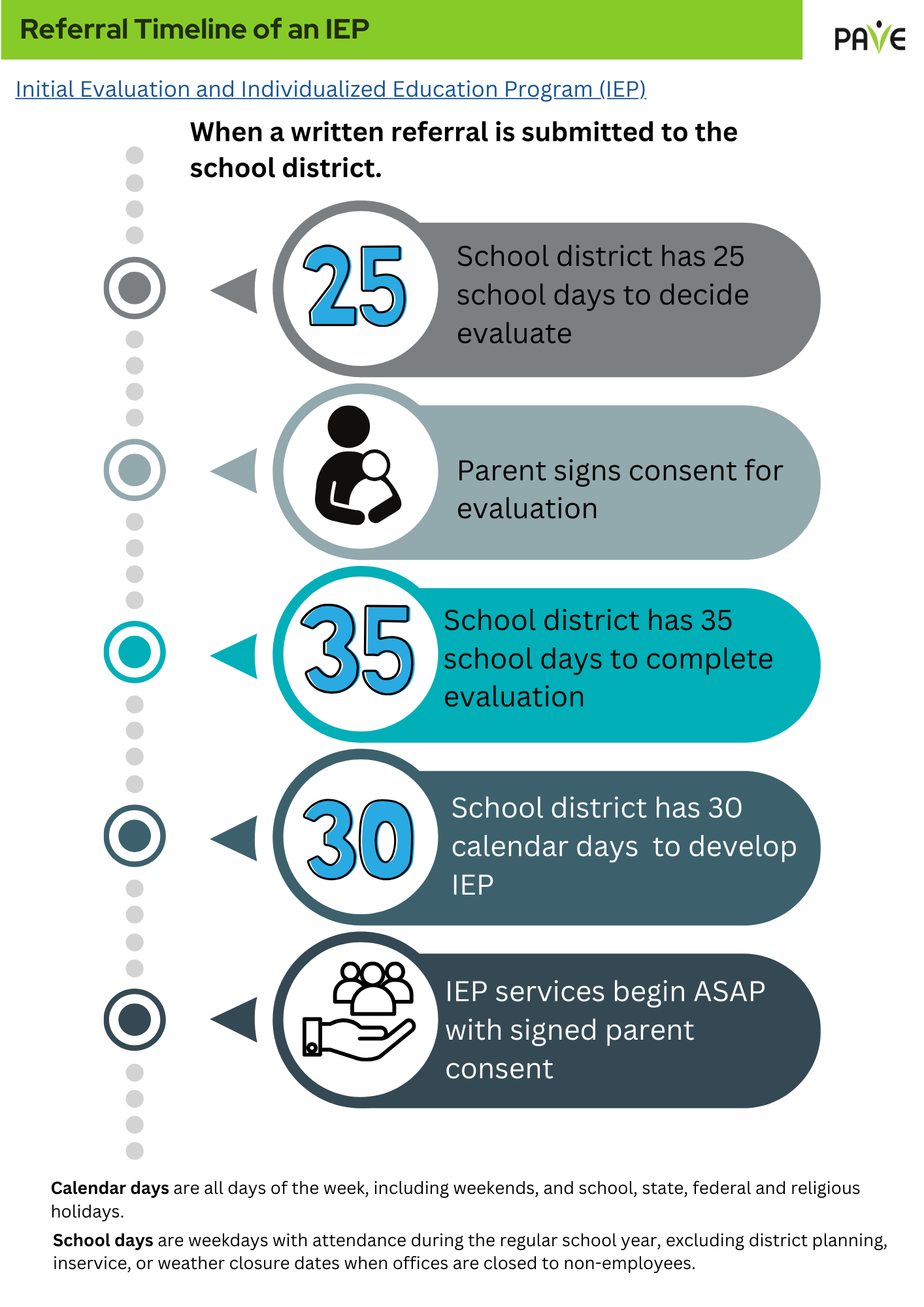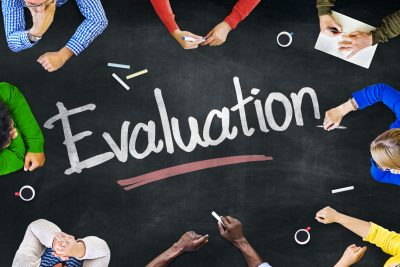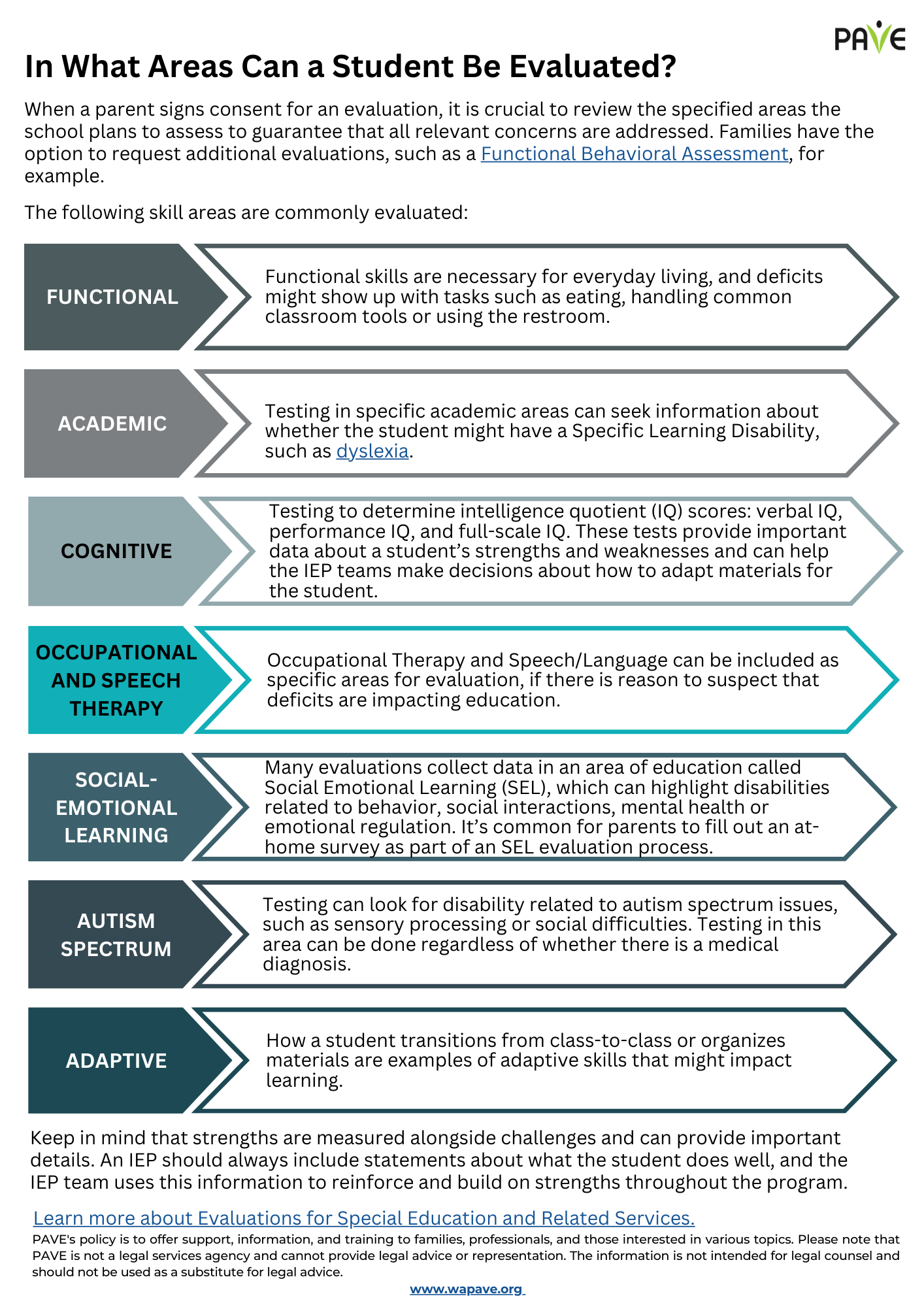A Brief Overview
- Special Education is provided through the Individualized Education Program (IEP) for a student with a qualifying disability. The first step is to determine eligibility through evaluation. This article describes that process and provides information and resources related to each eligibility category.
- Specially Designed Instruction (SDI) is the “special” in special education. The evaluation determines whether SDI is needed to help a student overcome barriers of disability to appropriately access education. Learning to ask questions about SDI can help families participate in IEP development. To learn more, watch PAVE’s three-part video series: Student Rights, IEP, Section 504, and More.
- Washington law requires evaluation referrals in writing. The state provides a form for referrals, downloadable from a website page titled, Making a Referral for Special Education. The person making the referral can use the form or any other format for their written request.
- PAVE provides a Sample Letter to Request Evaluation.
Full Article
If a student is having a hard time at school and has a known or suspected disability, the school evaluates to see if the student qualifies for special education. A child is protected in their right to be evaluated by the Child Find Mandate, which is part of the federal Individuals with Disabilities Education Act (IDEA).
If eligible, the student receives an Individualized Education Program (IEP). Information collected during the evaluation is critical for building the IEP.
The school follows specific deadlines for an evaluation process. They have 25 school days to respond to the referral in writing. If they proceed with the evaluation they have 35 schools days to complete the assessment. For an eligible student, an IEP must be developed within 30 calendar days.
If parents disagree with the school’s evaluation, they can request an Independent Educational Evaluation (IEE) in writing. The school must either pay for the IEE or defend its evaluation and their IEE denial through Due Process. PAVE provides an article, Evaluations Part 2, with more information and a sample letter for requesting an IEE.
Complaint options and family/student rights are described in the Procedural Safeguards, downloadable in multiple languages on the website of the Office of Superintendent of Public Instruction (OSPI).

Evaluation is a 3-part process
Not every student who has a disability and receives an evaluation will qualify for an IEP. The school district’s evaluation asks 3 primary questions in each area of learning that is evaluated:
- Does the student have a disability?
- Does the disability adversely impact education?
- Does the student need Specially Designed Instruction (SDI)?
If the answer to all three questions is Yes, the student qualifies for an IEP. After the evaluation is reviewed, the IEP team meets to talk about how to build a program to meet the needs that were identified in the evaluation. A summary of the most important findings is listed in the Adverse Educational Impact Statement on the IEP. Additional findings become part of the present levels statements, which are matched with IEP goal-setting and progress monitoring.
TIP: Read the Adverse Educational Impact Statement carefully to make sure it captures the most important concerns. The rest of the IEP is responsible to serve the needs identified in this statement. Families can request changes to this statement at IEP meetings. PAVE’s article, Advocacy Tips for Parents, provides information to help families prepare for and participate in meetings.
Don’t wait to evaluate because of provider wait lists
Depending on a student’s suspected areas of disability (see categories listed below), the district may need medical information. However, the school cannot delay the evaluation while requiring parents to get that medical information. If medical information is necessary for an eligibility determination, the district must pay for the outside evaluation. OSPI includes more detail about these requirements in a Technical Assistance Paper (TAP No. 5).
What areas can be evaluated?
When a parent signs consent for an evaluation, looking through the list of areas the school intends to evaluate is important to ensure that all concerning areas are included. Families can request additional areas to include in the evaluation, including a Functional Behavioral Assessment, for example.
Listed below are examples of skill areas that are commonly evaluated:
- Functional: Functional skills are necessary for everyday living, and deficits might show up with tasks such as eating, handling common classroom tools or using the restroom.
- Academic: Testing in specific academic areas can seek information about whether the student might have a Specific Learning Disability, such as dyslexia.
- Cognitive: Testing to determine intelligence quotient (IQ) scores: verbal IQ, performance IQ, and full-scale IQ. These tests provide important data about a student’s strengths and weaknesses and can be important for IEP teams making decisions about how to adapt materials to ensure accessibility.
- OT and Speech: Occupational Therapy and Speech/Language can be included as specific areas for evaluation, if there is reason to suspect that deficits are impacting education.
- Social-Emotional Learning: Many evaluations collect data in an area of education called Social Emotional Learning (SEL), which can highlight disabilities related to behavior, social interactions, mental health or emotional regulation. It’s common for parents to fill out an at-home survey as part of an SEL evaluation process.
- Autism Spectrum: Testing can look for disability related to autism spectrum issues, such as sensory processing or social difficulties. Testing in this area can be done regardless of whether there is a medical diagnosis.
- Adaptive: How a student transitions from class-to-class or organizes materials are examples of adaptive skills that might impact learning.
TIP: Keep in mind that strengths are measured alongside challenges and can provide important details. An IEP should always include statements about what the student does well, and the IEP team uses this information to reinforce and build on strengths throughout the program.
Below is an infographic showing this: See this infographic in PDF form
Eligibility Categories of Disability
Areas of evaluation are associated with 14 eligibility categories. These are broad categories, and sometimes there is discussion about which is the best fit to capture information about a student’s unique situation. Please note that there is no such thing as a “behavior IEP” or an “academic IEP.” After a student qualifies, the school is responsible to address all areas of need and design programming, services and a placement to meet those needs. An IEP is an individualized program, built to support a unique person and is not a cut-and-paste project based on the category of disability.
Below is a list of the 14 eligibility categories, including some information about places to get further information or specific resources.
- Autism: A student does not need a medical diagnosis to be evaluated by the school. If features of autism may significantly impact access to learning, then the school can assess those features to determine eligibility and special education needs. See PAVE’s article about Autism Spectrum Disorder for information and resources.
- Emotional Disturbance: Psychological or psychiatric disorders (anxiety, depression, schizophrenia, post-traumatic stress, etc.) can fall under this category, which Washington State refers to as Emotional Behavioral Disability (EBD). Please note that all eligibility categories are intended to identify the needs of students and are not intended to label children in ways that might contribute to stigma or discrimination. PAVE provides a Behavioral Health Toolkit for Navigating Crisis, School-Based Services, Medical Services, Family Support Networks, and More.
- Specific Learning Disability: Issues related to dyslexia, dysgraphia, dyscalculia, or other learning deficits can be educationally assessed. A formal diagnosis is not required for a student to qualify under this category. The school might find, for example, that a student has a reading disability “with the characteristics of dyslexia,” although the school may not be willing to name the condition using formal diagnostic terms. Washington requires schools to screen primary school children for dyslexia. The Office of Superintendent for Public Instruction (OSPI) has information about state requirements. PAVE provides an article, Dyslexia Screening and Interventions: State Requirements and Resources, and a video,Supporting literacy: Text-to-Speech and IEP goal setting for students with learning disabilities.
- Other Health Impairment: ADHD, Tourette’s Syndrome and other medical diagnoses are captured within this broad category, often shorted to OHI or Health-Impaired on the IEP document. Sometimes a Related Service is needed to assess a student because school staff do not have the expertise to properly understand a disability condition in order to make service recommendations. “Medical services for diagnostic or evaluation purposes” are written into federal law (IDEA Section 1432) as something schools provide at no cost to the family, if necessary as part of special education process.
- Speech/Language Impairment: This category can include expressive and/or receptive language disorders in addition to issues related to diction (how a student is able to produce sounds that are understood as words). Social communication deficits also might qualify a student for speech services. The Washington Speech Language Hearing Association (wslha.org) provides Consumer Information on its website and published a downloadable resource, Guidelines for Evaluation and Identification of Students with Communication Disorders.
- Multiple Disabilities: Students with complex medical and learning needs can meet criteria in this category. Depending on their impairments, a student eligible in this category might receive services in a range of ways that overlap with other disability categories. Washington Sensory Disabilities Services (WSDS.wa.gov) may have information and resources to support families and schools in these complex situations.
- Intellectual Disability: A student with Down Syndrome or another genetic or cognitive disorder might meet criteria in this category. Washington State’s Department of Social and Health Services manages the Developmental Disabilities Administration (DDA) that provides services for people with intellectual and developmental disabilities (I/DD). DDA’s Informing Families website and newsletter is a place for information and resources. A child with a disability related to I/DD may be identified early and receive Birth-3 services through an Individualized Family Service Plan (IFSP). PAVE provides an Early Learning Toolkit.
- Orthopedic Impairment: OI refers to physical disabilities that impact access to education. PAVE provides an article about Related Services to help families understand services provided through school versus the medical system.
- Hearing Impairment: Whether permanent or fluctuating, a hearing impairment may adversely affect a child’s educational performance. The Center for Deaf and Hard of Hearing Youth (cdhy.wa.gov) provides information and resources for families and schools. Another place for information is Washington Sensory Disabilities Services (WSDS.wa.gov).
- Deafness: A student unable to process linguistic information through hearing, with or without amplification, may be eligible for services under this category. The Center for Deaf and Hard of Hearing Youth (cdhy.wa.gov) provides information and resources for families and schools.
- Deaf blindness: A combination of hearing and visual impairments establishes a unique set of special education service needs. The Washington DeafBlind Program (deafblindprogram.wa.gov) provides information about seeking educational support and connecting with other families.
- Visual Impairment/Blindness: Partial sight and blindness may fit this category when, even with correction, eyesight adversely affects a child’s educational performance. Washington State’s Department of Services for the Blind (DSB) is an agency that provides youth and adult services for individuals who are blind or low vision. Other places to seek resources and information are Washington Sensory Disabilities Services (WSDS.wa.gov) and Outreach services from the Washington State School for the Blind (wssb.wa.gov/services/outreach).
- Traumatic Brain Injury: The state provides resources related to TBI, including guidance about Returning to School After Traumatic Brain Injury. Another place for resources and support is the Brain Injury Alliance of WA.
- Developmental Delay (ages 0-9): This category can qualify a child for early learning (Birth-3) services in addition to IEP services through age 9. By age 10, a new evaluation may determine eligibility in another category for IEP services to continue. PAVE’s Early Learning Toolkit includes information to support families of babies, toddlers, preschoolers, and children in early elementary school.
What to do if you disagree
The IDEA requires schools to use “technically sound” instruments in evaluation. Generally, that means the tests are evidence-based as valid and reliable, and the school recruits qualified personnel to administer the tests. The IDEA is clear that a singular measure, such as an Intelligence Quotient (IQ) test, does not meet the standard for an appropriate evaluation.
Parents can take action if they disagree with the way testing was done or the way it was interpreted.
Parents can always ask school staff to describe their decisions in writing, and parents have rights guaranteed by the IDEA to informally or formally dispute any decision made by the school. The Center for Appropriate Dispute Resolution in Special Education (CADRE) offers a variety of guidebooks that describe these options. In Washington State, the Office of Superintendent of Public Instruction (OSPI) provides state-specific guidelines for dispute resolution.
A student may qualify for a Section 504 Plan, if not an IEP
Section 504 is part of the Rehabilitation Act of 1973. This Civil Rights law protects individuals with disabilities that severely impact “major life activities,” such as learning, breathing, walking, paying attention, making friends… The law is intentionally broad to capture a wide range of disability conditions and how they might impact a person’s life circumstances.
A student with an IEP has protections from Section 504; those protections are included in the IEP.
Sometimes students who don’t qualify for the IEP will qualify for accommodations and other support through a Section 504 Plan. PAVE has an article about Section 504, which provides an individual with protections throughout the lifespan.
Protections against bullying and discriminatory discipline are aspects of Section 504. Watch PAVE’s video, Behavioral Health and School: Key Information for Families.
Help from PAVE
PAVE’s Parent Training and Information (PTI) team provides 1:1 support and additional resources. Click Get Help or Call 1-800-5PARENT (572-7368) and select extension 115, English or Spanish available, to leave a dedicated message.


